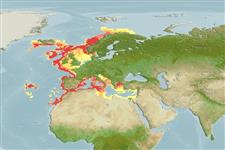Classification / Names
Common names from other countries
Main reference
Size / Weight / Age
Max length : 150 cm TL male/unsexed; (Ref. 35388); max. published weight: 2.5 kg (Ref. 4645)
Length at first maturity
Lm 45.9 range ? - ? cm
Environment
Marine; bathydemersal; oceanodromous (Ref. 51243); depth range 40 - 1400 m (Ref. 104125), usually 300 - 500 m (Ref. 4443)
Climate / Range
Deep-water, preferred 9°C (Ref. 107945); 75°N - 27°N, 32°W - 35°E
Distribution
Eastern Atlantic: northern Norway and Iceland, Skagerrak and Kattegat south to Morocco including western Mediterranean (some isolated records from eastern part), Azores and Madeira Islands. Records from South Africa are questionable. Reported from Oshima, Japan (FMNH 89161) (Ref. 27954).
Countries | FAO areas | Ecosystems | Occurrences | Introductions
IUCN Red List Status (Ref. 115185)
Threat to humans
Traumatogenic (Ref. 4690)
Human uses
Fisheries: minor commercial
More information
ReferencesAquacultureAquaculture profileStrainsGeneticsAllele frequenciesHeritabilityDiseasesProcessingMass conversion
Tools
Special reports
Download XML
Internet sources
Estimates of some properties based on models
Phylogenetic diversity index
PD50 = 0.5000 many relatives (e.g. carps) 0.5 - 2.0 few relatives (e.g. lungfishes)
Trophic Level
3.5 ±0.0 se; Based on diet studies.
Resilience
Low, minimum population doubling time 4.5 - 14 years (Assuming Fec <100;)
Vulnerability
High to very high vulnerability (74 of 100)
Price category
